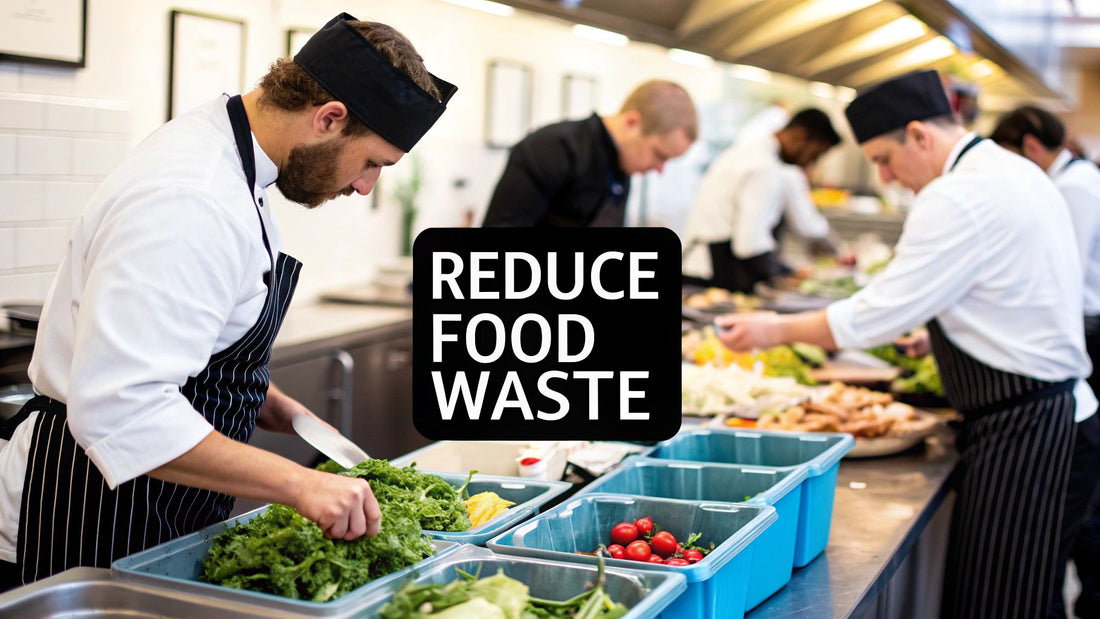
Reducing Food Waste in Restaurants: Top Strategies to Save Costs
Share
Let's be honest, reducing food waste is one of the most effective ways to pad your restaurant's bottom line. It's not about one magic fix, but a series of smart, connected habits: running regular food waste audits, nailing your inventory with a strict first-in, first-out system, designing menus that make ingredients work double-duty, and teaching your team the art of portion control. Stay informed about the latest industry trends and find exclusive deals on the restaurant equipment and supplies that make these strategies possible. This isn't just about saving scraps; it's about turning what you'd normally toss into profit.
The Real Price Tag on Your Restaurant's Food Waste
Every chef and owner feels the sting of throwing food away—it's money straight into the bin. But the real financial hit goes way beyond the cost of that wilted lettuce or yesterday's unsold special. Food waste is a silent profit killer, slowly and steadily bleeding money from all corners of your business.
Just think about the life cycle of a single tomato. You paid for the tomato itself, sure. But you also paid for the labor to order it, receive it, and put it away. You're paying for the electricity to keep it cool in the walk-in and for the prep cook's time to wash and slice it. If that tomato ends up in the trash, every single cent you invested in that journey is gone. It's this domino effect of hidden costs that really eats into your margins.
Finding the Hidden Leaks in Your Budget
Tackling food waste isn't just about being green; it's one of the sharpest business moves you can make. The losses are hiding in plain sight, and they go far beyond what you see in the dumpster.
- Buying Too Much: Guessing on your produce order is a recipe for disaster. It leads to an overstuffed walk-in where food inevitably spoils before you can use it. Every forgotten case of mushrooms or expired carton of cream is a direct loss.
- Wasting Your Team's Time: Think about the payroll hours spent prepping food that never gets sold. That's skilled labor you're paying for that produces absolutely zero revenue.
- Driving Up Utility Bills: A packed-out storage area means your refrigerators and freezers have to work overtime, which shows up on your electricity bill. All that extra washing and rinsing of unused product also means higher water usage.
This is a massive problem. On a global scale, food waste slices about $1 trillion out of the economy every year, and restaurants are a huge piece of that pie. The data is clear: full-service restaurants are some of the biggest offenders, tossing millions of tons of food from simple ordering mistakes, over-prepping in the kitchen, and what customers leave behind. You can dig deeper into the restaurant food waste statistics to see just how big the issue is.
Change how you look at it. Waste reduction isn't a chore—it's a direct line to a healthier bottom line. Every carrot stick or fish filet you save is money that goes right back into your pocket.
Conduct a Smart Audit to Master Your Inventory
You can't fix a problem you can't see. The first real step to cutting down food waste is getting a clear picture of what you have, what’s being used, and what’s getting tossed. A food waste audit isn't about creating more work; it's about trading guesswork for hard data so you can make smarter decisions.
This doesn't have to be some overly complicated process. Start simple. Set up a few dedicated, clearly labeled bins in the kitchen for different kinds of waste: prep scraps (think veggie peels and trim), spoiled ingredients, and plate leftovers from the dining room.
Just by weighing these bins at the end of each shift for a week or two, you'll start seeing patterns emerge. Maybe you'll find you're consistently over-prepping a certain side dish, or that a specific produce delivery always seems to spoil faster than it should. These are the clues that lead to real savings.
Fine-Tuning Your Inventory System
Once you know where the waste is happening, you can get to the root of the problem. This is where a strict ‘first-in, first-out’ (FIFO) system becomes your best friend. It’s a simple concept—new stock goes behind the old stock—but enforcing it consistently is what keeps ingredients from getting lost in the back of the walk-in until they're unusable.
Your audit data also helps you set more accurate inventory pars. If you’re throwing out half a case of avocados every single week, your gut feeling on ordering is costing you money. It’s time to adjust that standing order based on what you actually sell. This is also a good opportunity to build a more transparent relationship with your suppliers, which can lead to more flexible, just-in-time ordering that truly matches your daily needs.
For a deeper dive, check out these proven inventory management tips for handling ordering, storage, and sales more effectively.
This graphic really breaks down how a solid waste audit flows from measurement to meaningful action.
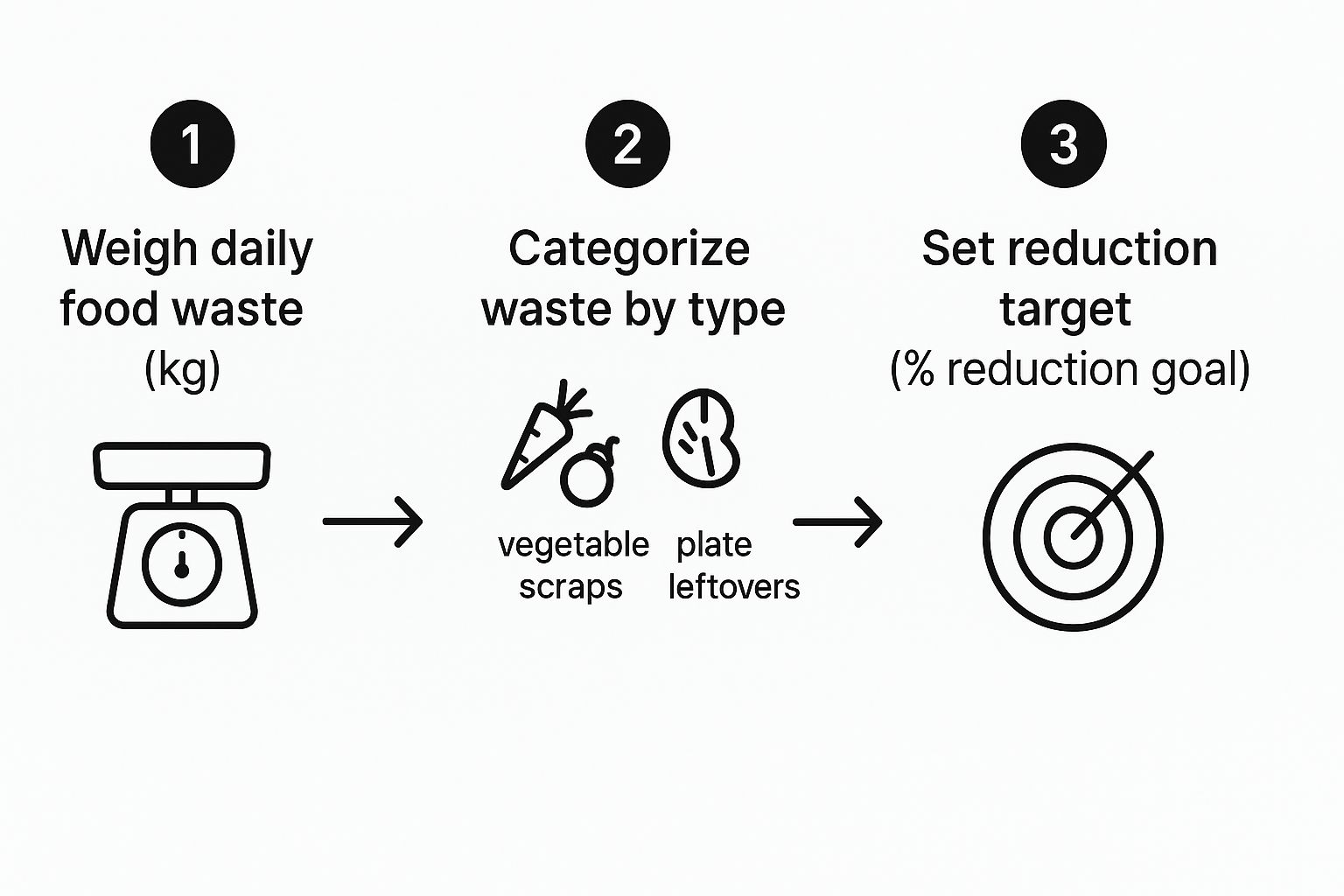
It’s a great visual reminder of how systematic tracking gives you a clear roadmap for improvement, turning raw numbers into a solid plan.
To make this process even easier, here’s a checklist you can use to guide your team's waste audit. It helps categorize everything and set clear goals from the get-go.
Your Kitchen's Food Waste Audit Checklist
| Waste Category | What to Track (Examples) | Measurement Method | Actionable Goal |
|---|---|---|---|
| Spoilage | Produce that went bad, expired dairy, moldy bread | Weigh by the pound/kilogram daily | Reduce weekly spoilage by 15% by adjusting produce orders |
| Prep Waste | Vegetable peels, meat trim, unused garnishes | Weigh and list top 3 items by volume | Find creative uses for trim (stocks, specials) to cut prep waste by 20% |
| Plate Waste | Un-eaten food returned from tables, common side dishes left | Weigh and note common leftover items | Re-evaluate portion sizes on the two most-returned dishes |
| Overproduction | Batch-cooked items that didn't sell (soups, sauces) | Record volume/portions of discarded batches | Adjust batch sizes based on sales data to reduce overproduction by 25% |
By using a simple framework like this, you can quickly identify your biggest opportunities for improvement and create targeted, achievable goals.
Using Technology to Sharpen Your Edge
Modern inventory management software can take a lot of the manual labor and human error out of this process. There are tools for every budget, from simple mobile apps to POS-integrated systems that provide real-time data, flag items nearing their expiration date, and even help generate purchase orders based on sales forecasts. For exclusive deals on the latest restaurant supplies and equipment, staying informed on industry trends is key.
“We were shocked that literally overnight we were able to add 2% to the bottom line with no operational changes.” - Goop Kitchen, Los Angeles, CA
Having this level of control ensures every last ingredient is accounted for and used efficiently. Of course, the right hardware is just as important. Your refrigeration units are the guardians of your inventory, and if they aren't working properly, you're just throwing money away. Learning about proper commercial kitchen equipment maintenance will help keep your gear in top shape and protect your stock.
When you combine a hands-on audit with the right tech and well-maintained equipment, you create a powerful system that stops waste before it even has a chance to start.
Rethink Your Kitchen Prep and Menu Design
Once you get a handle on your inventory, the next big battleground in the war on waste is your kitchen itself. This is where you can make some of the biggest impacts by changing how you prep ingredients and design your menu. It’s where a little bit of creativity and a lot of smart planning come together to stop waste before it even starts.
It all begins with adopting a “root-to-stem” or “nose-to-tail” cooking philosophy. This isn’t just some trendy tagline; it’s a seriously practical business strategy. Before you toss those vegetable peels, herb stems, or meat trimmings, stop and think of them as assets, not trash.
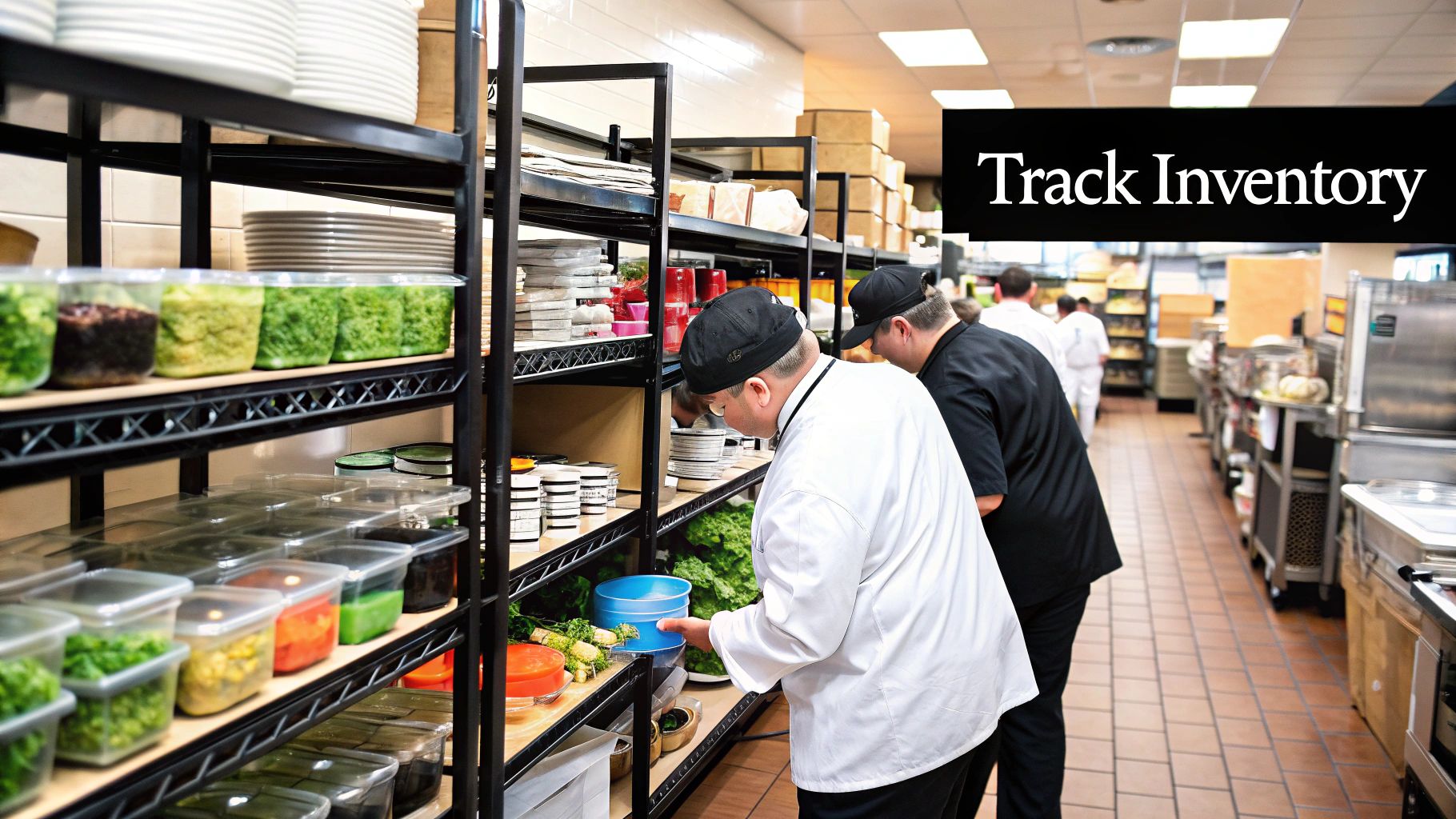
What can you do with them? Those carrot peels and onion ends are the perfect base for a rich, flavorful vegetable stock. The stems from that bunch of parsley or cilantro can be blitzed into a vibrant pesto or chimichurri. Even the off-cuts from your fish or steak can be transformed into amazing staff meals, savory pies, or a profitable daily special. This mindset doesn't just slash your waste—it adds incredible depth to your dishes and gives your bottom line a healthy boost.
Engineer a Waste-Proof Menu
Your menu is probably the most powerful weapon you have against waste. A well-engineered menu is designed for cross-utilization, which is just a fancy way of saying you use the same ingredients in multiple dishes. This drastically cuts down on the risk of spoilage for that one ingredient you only use in a single, slow-selling dish.
Take a hard look at your inventory and start connecting the dots. If you’re buying fresh basil for a Caprese salad, how else can you use it? Maybe it can star in a pasta sauce, get muddled into a signature cocktail, or be used as a fresh garnish for another popular plate. The idea is to make sure the entire case of basil gets used up quickly while it's still at peak freshness. A smart kitchen setup is also key here; a well-designed commercial kitchen design layout can make this kind of efficient workflow second nature for your team.
The goal is to create a symbiotic relationship between your dishes. When one ingredient can shine in multiple roles, you dramatically reduce the chances of it ending up in the trash.
Nail Your Portion Control with Precision
Inconsistent portioning is a quiet killer of profits. It creates plate waste when servings are too big and drives up your food costs. I've seen it time and again. A global report estimated that 4% to 10% of food restaurants buy is wasted before it even reaches a customer, while a shocking 31% to 40% of food that is served gets left on the plate. A lot of that comes down to oversized portions.
To fix this, standardized recipes are completely non-negotiable. Every single dish needs a clear, documented recipe that spells out the exact weight or measurement for every component. This is where having the right tools for the job makes all the difference. Discover the latest news and deals on essential restaurant supplies to help.
- Digital Scales: Every protein portion should be weighed. No exceptions.
- Portion Scoops and Spoodles: These ensure you get consistent servings of sides, sauces, and starches every time.
- Standardized Glassware: Control your beverage pours and stop over-pouring profits down the drain.
By equipping your team with these simple tools and training them to use them religiously, you take the guesswork out of plating. The result? A consistent, high-quality product for your guests and a serious drop in waste from oversized servings.
And while we're on the topic of kitchen systems, implementing effective food allergen labelling practices is a must. It's obviously critical for guest safety, but it's also a waste-reduction tool. Correctly labeling prepped ingredients and batches prevents costly mix-ups and cross-contamination that can force you to throw out an entire batch of food. It protects your customers and your inventory.
Engage Your Team to Reduce Plate Waste
Reducing food waste isn’t just a back-of-house job. Your front-of-house team is on the front lines, talking directly to customers, and they are absolutely crucial in minimizing what gets left on the plate. When you give them the right training and tools, every server becomes an active partner in hitting your sustainability and profitability goals.
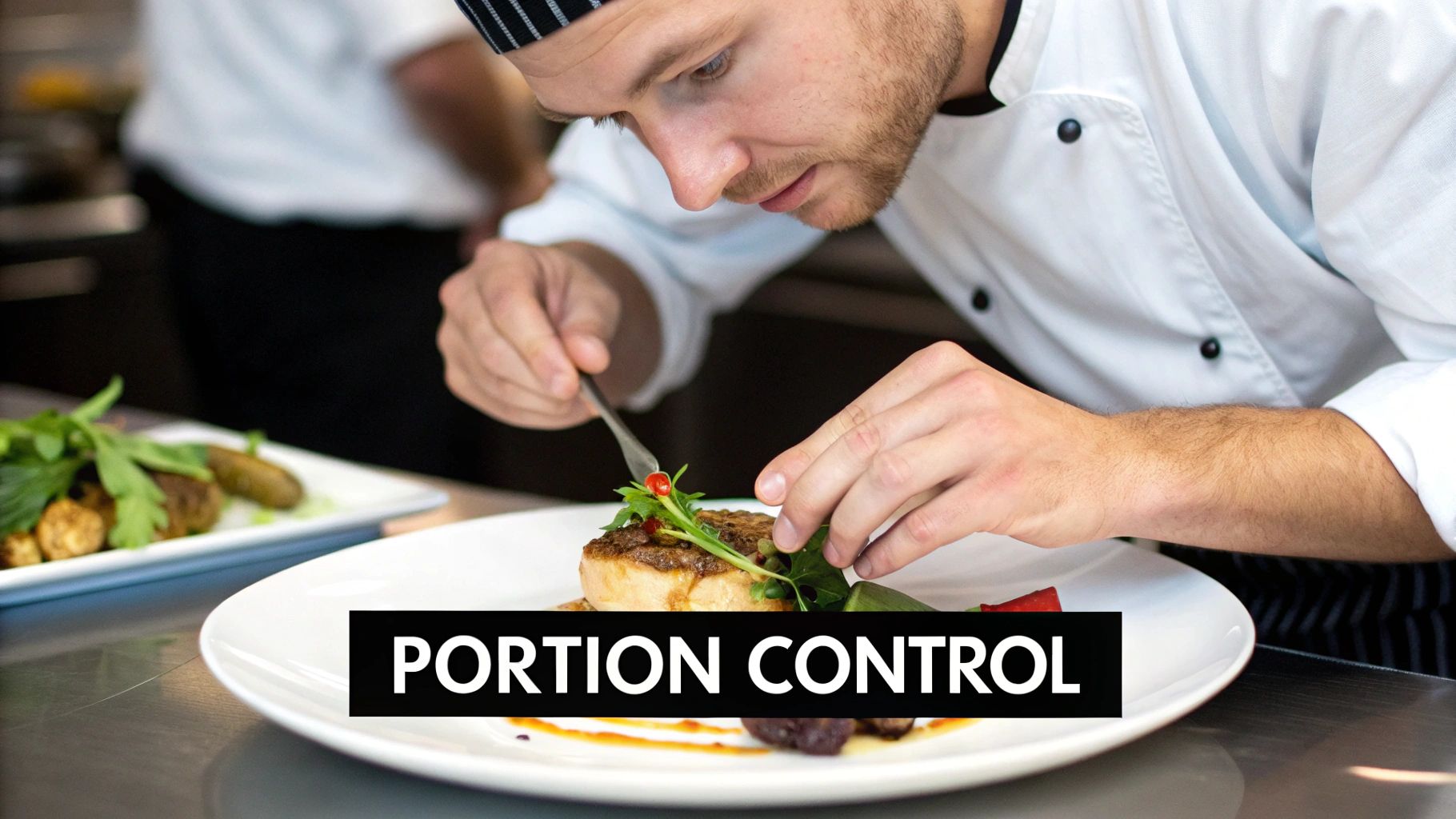
This goes way beyond simply memorizing the daily specials. Your staff needs to understand the why behind your waste reduction efforts—how it directly affects the restaurant's bottom line and, on a bigger scale, the environment. When they grasp the bigger picture, they're not just following orders; they're invested in finding solutions.
Smart Service Strategies That Cut Waste
Simple, thoughtful adjustments in how your team interacts with guests can make a world of difference. Your servers are in the perfect position to guide customers toward choices that result in less waste, all without taking away from the dining experience.
A well-trained server can do more than just list ingredients; they can paint a picture of the portion size. Imagine a server noticing a guest seems hesitant about a large dish. Instead of just taking the order, they could say, "Just so you know, our steak is a pretty generous 12-ounce cut. We can also do a smaller 8-ounce portion if you'd prefer."
This kind of proactive guidance is exactly what prevents those half-eaten plates from returning to the kitchen. It’s a win-win. To get a real pulse on how your team feels and to gather their own brilliant ideas, you might want to use a staff engagement survey template.
Here are a few practical training points to get your team started:
- Offer Flexible Portions: Make it second nature for staff to mention half-portions or smaller plate options.
- Provide Honest Descriptions: Coach them to give guests a genuine idea of dish sizes. No one likes to be surprised by a mountain of food they can't finish.
- Encourage Take-Home Thoughtfully: A simple, warm offer like, "Would you like me to box that up for you to enjoy later?" can make all the difference. It normalizes taking home leftovers and keeps good food out of the bin.
A server who can guide a guest to the perfect-sized meal is providing superior customer service. It’s not about restriction; it’s about ensuring a satisfying experience that just happens to be more sustainable.
The Psychology of Plating and Menu Language
How you present food visually and verbally has a huge impact on ordering habits. Thoughtful plating, for instance, can make a perfectly reasonable portion look abundant and satisfying, which subtly reduces the customer's perceived need for a massive serving. Even something as simple as using slightly smaller plates for certain dishes is a classic trick that really works.
Your menu descriptions are just as important. Words like "hearty," "generous," or "perfect for sharing" set clear expectations right from the start. This isn't about trickery; it's about clear communication that helps align what a guest expects with the reality of the portion. The result? Cleaner plates and a much healthier profit margin. When your entire team, from front to back, is working with this shared goal, reducing food waste just becomes part of your restaurant's culture.
Get Smart with Tech and Creative Waste Diversion
Even the tightest-run kitchens will have some leftovers. The real trick is to stop thinking of those scraps as trash and start seeing them as an asset you haven't used yet. With the right tech and a little creativity, you can transform what used to be a straight loss into a win for your bottom line and your community.
It all starts with a mental shift. What is really "waste"? This is where some incredible AI-powered platforms are changing the game for restaurants. These systems plug right into your POS, giving you hyper-accurate, dish-by-dish forecasts that practically build your prep lists, guide your ordering, and even help you staff smarter. You're no longer running on gut feelings; you're using real data to cook exactly what you need.
Put Smart Kitchen Technology to Work
Imagine knowing, with a high degree of certainty, how many orders of salmon you’ll sell on a rainy Tuesday. That's what these AI tools do. They chew through your past sales data, look at weather forecasts, and even check for local events to predict what your customers will want.
No more over-prepping the soup special "just in case" or getting stuck with a case of avocados before a surprisingly slow weekend. It’s all about making sharp, proactive decisions that slash waste before it ever happens.
These platforms deliver easy-to-read reports that pinpoint your biggest chances to save money. The impact can be huge and fast—some kitchens have boosted their bottom line by 2% or more almost instantly just by syncing their prep with actual demand. Smarter forecasting also dominoes into better ordering, which is a key part of any solid bar inventory management systems.
Technology lets you get ahead of waste instead of just reacting to it. Your sales data becomes a crystal ball, helping ensure every ingredient you buy is destined for a plate, not the bin.
Find a Better Home for Your Scraps
Once you've trimmed all the waste you can with smart tech and sharp kitchen habits, you need a plan for what’s left over. The landfill should be your absolute last option. In the U.S., food is the single biggest item filling up our dumps, accounting for a jaw-dropping 24% of all buried municipal waste. We can do so much better. You can dive deeper into these food waste diversion strategies to see the potential impact.
Here are a few powerful ways to divert that waste from the landfill:
- Set Up Composting: Most areas now have commercial composting services that will happily pick up your organic waste. All those vegetable peels, coffee grounds, and plate scrapings can be turned into rich soil instead of producing methane in a landfill.
- Donate, Don't Dump: Find a local food bank, shelter, or charity and build a relationship. Perfectly good, unserved food can help feed people in need, turning a potential loss into a massive community good.
- Recycle That Cooking Oil: Used fryer oil has no business going down the drain. There are specialized companies that will collect it from your restaurant and convert it into clean-burning biofuel.
Your Top Questions About Restaurant Food Waste, Answered
Jumping into a food waste reduction program can feel like a huge project. You know it’s the right thing to do for your profits and for the planet, but it’s totally normal to have questions about where to begin, how to handle the costs, and what kind of results you can actually expect. Let's break down some of the most common questions I hear from operators.
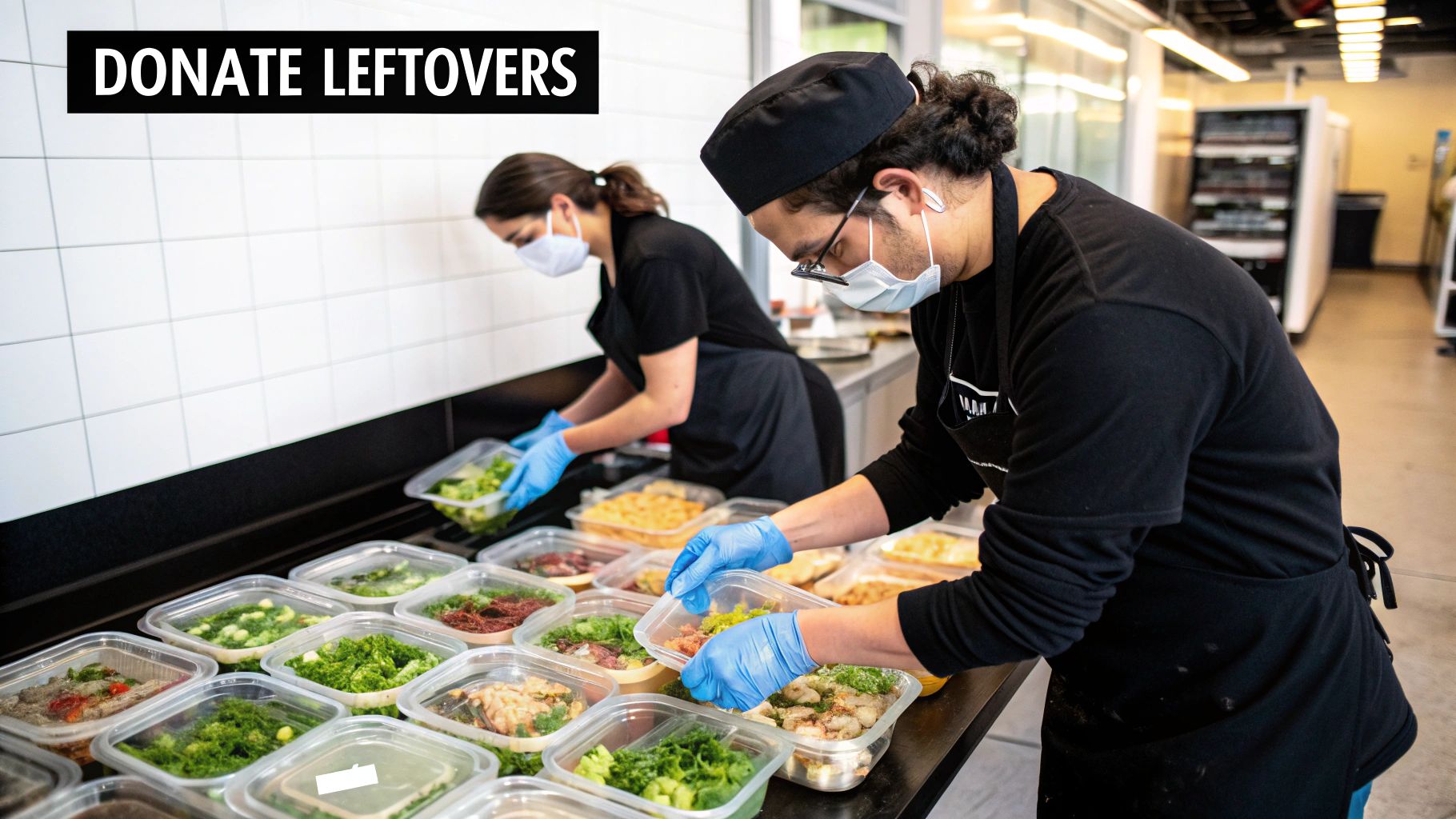
Where's the Best Place to Start?
The most powerful first step is also the simplest: conduct a food waste audit. Seriously, you can't manage what you don't measure. For just one week, get a few clear bins and start tracking everything you toss out. Categorize it—spoilage, prep scraps, customer plate waste.
This data is gold. It’s your treasure map to savings. You might find that one side dish is consistently coming back uneaten, or that a case of a certain vegetable always goes bad before you can get through it. This simple exercise will shine a spotlight on your biggest waste culprits, showing you exactly where to focus your efforts for reducing food waste in restaurants.
Do I Really Need to Buy New Equipment?
Look, you can definitely make a dent without a big upfront spend. But the right tools can supercharge your efforts and make those new habits stick for the long haul. Don't think of it as an expense; think of it as an investment with a killer ROI. Restaurant owners and chefs can discover exclusive deals and the latest news on the restaurant equipment and supplies that will provide the best return.
A vacuum sealer, for example, can easily double the shelf life of your proteins and produce, which directly slashes your spoilage costs. High-quality digital scales are non-negotiable for locking down portion control and making sure recipes are followed to the gram. Even something as basic as upgrading to better, energy-efficient coolers can keep food fresher for longer by maintaining more stable temperatures.
It's easy to balk at the price tag, but the payback period on smart equipment is often surprisingly short. A $300 vacuum sealer could easily save you thousands in food costs over a single year.
How Do I Get My Kitchen Staff to Actually Care?
This is the big one. Your team's buy-in is everything, and it all starts with explaining the why. Don't just post a new rule; show them the numbers. Explain how much money is literally going into the garbage can every single week. Connect the dots for them—saving that money means a healthier business, which can lead to better equipment, more stability, and maybe even team bonuses.
Then, turn them into part of the solution. Your line cooks and prep staff are on the front lines; they see the waste happening in real-time. Ask for their ideas! They might tell you that a certain vegetable is a pain to prep without a ton of waste, and a simple change in cutting technique or a different knife could solve it.
To make it real for them, try this:
- Set Clear, Achievable Goals: "Team, let's try to cut our main bin's weight by 10% this month."
- Give Them the Right Tools: Make sure they have sharp knives, proper Cambros for storage, and scales right where they need them.
- Celebrate the Wins: A simple "Hey, great job on waste this week, guys!" during pre-shift can make a huge difference.
When you empower your crew and give them ownership, reducing waste stops being a chore and becomes a shared mission. That sense of teamwork is what really creates a lasting culture of efficiency in the kitchen.
At Encore Seattle Restaurant Equipment, we've seen firsthand how the right tools can transform a kitchen's efficiency. We help restaurant owners and chefs discover the latest news and exclusive deals on restaurant equipment and supplies. We stock a massive selection of new and used equipment—from precision scales to commercial refrigeration—all designed to help you cut waste and boost your bottom line. Find what you need to build a more profitable and sustainable restaurant at https://encoreseattle.com.
